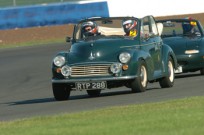final drive ratios.
Forum rules
By using this site, you agree to our rules. Please see: Terms of Use
By using this site, you agree to our rules. Please see: Terms of Use
final drive ratios.
Is there any markings on the outside of an axle to indicate the ratio,or any other way of finding out,without taking the cover off.
Re: final drive ratios.
I believe there is a marking on the shank of the axle casing - otherwise - turn the pinion and count the turns to make one rev of the wheel.....and then double it...



-
philthehill
- Minor Maniac
- Posts: 11594
- Joined: Thu Jul 19, 2012 12:05 pm
- Location: Hampshire
- MMOC Member: Yes
Re: final drive ratios.
The numbers are usually stamped on the top of the diff housing/stud flange. i.e. 9/41 (4.55) for a standard 948 cc engined Minor.
Re: final drive ratios.
cheers,will have a look.
-
chesney
- Minor Legend
- Posts: 1140
- Joined: Thu Jan 19, 2012 4:55 pm
- Location: Le Tronquay, nr Bayeux, en France - Pop in for a cuppa!
- MMOC Member: No
Re: final drive ratios.
You can ascertain whether it is a 4.55 diff or a 4.22 as the 4.55 uses a filler plug on the diff itself, the 4.22 relies on having one on the casing of the axle.
-
IslipMinor
- Minor Legend
- Posts: 2147
- Joined: Mon May 10, 2004 9:10 pm
- Location: Oxford, UK
- MMOC Member: Yes
Re: final drive ratios.
The most reliable way is to jack up one rear wheel, make sure the gearbox is in neutral, turn the jacked-up wheel so that the valve is somewhere obvious and repeatable, like at the bottom, note position of the grease nipple at the rear of the propshaft, or make a mark on the propshaft, then turn the propshaft carefully counting the turns until the jacked-up wheel has completed exactly 2 turns. Note how many turns and parts of a turn the propshaft has made and that is your diff ratio! Or turn the jacked-up wheel exactly 2 turns and count the propshaft turns and parts of a turn to get the same result.
Note! This does not work on limited slip diffs, where you have to jack up under the diff to get both wheels off the ground. However jacking up both wheels with a standard 'open' type diff is likely to be unreliable, as the diff will allow one side to slip in relation to the other, so you will never know exactly the number of wheel turns with any confidence.
Note! This does not work on limited slip diffs, where you have to jack up under the diff to get both wheels off the ground. However jacking up both wheels with a standard 'open' type diff is likely to be unreliable, as the diff will allow one side to slip in relation to the other, so you will never know exactly the number of wheel turns with any confidence.
Richard



